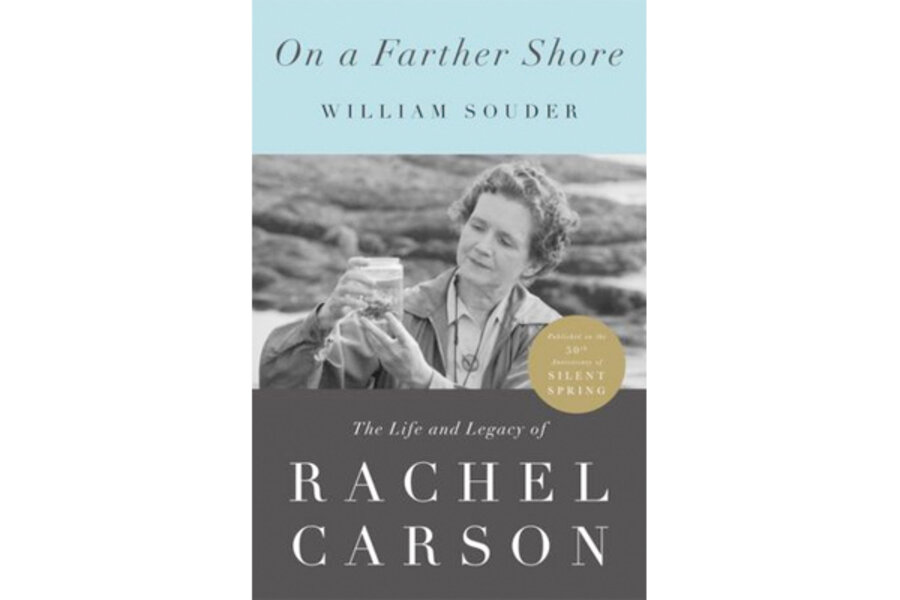On a Farther Shore
Loading...
In the mid-20th century, the idea called conservation died and rose again in a pessimistic, partisan incarnation known as environmentalism, which hinged on a central idea: mankind must be saved from itself. The writer who precipitated that transformation was Rachel Carson, author of "Silent Spring," a book that indicted the overuse of pesticides in the 1940s and 1950s. William Souder’s On a Farther Shore: The Life and Legacy of Rachel Carson, published on the 50th anniversary of "Silent Spring," is both a biography of the woman behind this seminal work and a history of humanity's relationship with nature in the mid-20th century.
That relationship had become tenuous in the years leading up to "Silent Spring." In the late 19th and early 20th centuries, prevailing wisdom held that humanity should conserve nature by creating natural reserves and protecting endangered species. But by the mid-20th century, the game had changed. New discoveries allowed scientists to manipulate nature with disconcerting results. A barrage of nuclear tests in the South Pacific, the American Southwest, and the Soviet Union caused radioactive ash to fall like snow in parts of the United States. Intensive pesticide spraying resulted in food contamination and deaths of workers brought into prolonged contact with pesticides. Souder brings these environmental disasters to light with harrowing details, such as his description of a Japanese fishing ship whose crew developed horrifying symptoms after sailing too close to a hydrogen bomb test.
By exposing the dangers of tampering with nature, Carson precipitated the invention of environmentalism, a movement that acknowledged that protecting the natural world also means protecting humanity from its own excesses. Carson’s book also created a paradigm for the environmental debates we know today. When 'Silent Spring" came out, Carson’s supporters compared the book to "Uncle Tom’s Cabin," her detractors called her a fraud and a communist, and government officials wrung their hands as they tried to decide what to do about pesticides. As Souder points out, these conversations surrounding pesticides in the 1960s were not so different from the conversations about global warming in the 2000s.
Souder describes the uproar surrounding Carson's book at the start and conclusion of "On a Farther Shore," but the middle of the book is devoted to a comprehensive biography of Carson, from the development of her interest in biology as an undergrad at Pennsylvania College for Women, to her government job at the Bureau of Fisheries, to her first forays into science writing, to her blossoming love for the Atlantic coast. Souder eloquently captures Carson's enduring passion for the ocean, from the peninsulas of Southport Island in Maine, where she bought a summer home and fell in love with her neighbor Dorothy, to the Florida coast, where she took a helmet-diving trip to research her book "The Sea Around Us," one of the three bestselling ocean science books she wrote before "Silent Spring."
Souder paints a portrait of a gentle, unassuming woman who was nevertheless ambitious, a woman who revised her writing endlessly and often turned in manuscripts years late – "Silent Spring" was originally slated for publication in early 1960 – and who tirelessly advocated for her own work, chastising her publishers when she felt they failed to adequately promote her books.
Souder, a science writer whose book about John James Audubon was a finalist for the 2005 Pulitzer Prize in biography, clearly admires Carson, and readers of "On a Farther Shore" will find themselves rooting for and sympathizing with his protagonist too, as she struggles to financially support her mother and orphaned nephew, as she slaves over revisions, and as she navigates her own failing health and succumbs to cancer in her 50s soon after the publication of "Silent Spring."
But even today, Carson is not universally admired. One of the substances she indicts in her book is DDT, a pesticide that was used to control disease-carrying insects and decrease malaria in many parts of the world. Carson’s detractors accuse her of causing the suspension of anti-malaria DDT programs in Africa and indirectly leading to millions of deaths. Souder points out that Carson's tunnel vision, a trait she exhibited throughout her life, probably contributed to her decision to focus almost exclusively on the negatives of pesticides. But he largely dismisses Carson’s critics. Souder explains that Carson never advocated for the complete elimination of pesticides – she simply warned against the wanton application of these substances. Souder also writes that even before "Silent Spring," officials were wondering whether the malaria program would become less effective as mosquitoes developed resistance to DDT.
Souder’s narrative sometimes loses focus, such as in a chapter he devotes largely to a biography of Henry Williamson, an English nature writer Carson admired. But by and large Souder's work is a compelling and compulsively readable portrait of one of the most influential writers of the last 50 years; a fascinating glimpse into the history of science’s dark incursions and excesses; and an illuminating portrait of the birth of the environmental controversies we know today.
Emily Cataneo is a journalist and book critic based in Boston.








